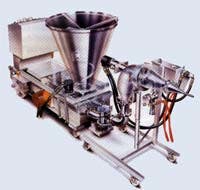For more than 40 years, Marlen Reasearch, Overland Park, Kansas., has designed and built food-processing equipment. Today, at the heart of Marlen’s systems for moving food products is their patented, twin-piston, positive-displacement pump. This pump can operate continuously in pressure-sensitive applications or provide precisely metered product flow. It has the ability to stall without increasing pressure or allowing product to bypass. This enables food processors to move a variety of products without damage. These include:
- abrasive foods (sugars, cornmeal)
- smear-sensitive foods (sausage)
- shear-sensitive foods (spinach, dough)
- foods that need high pressure to transfer (cheese), and
- foods that need protection of their particle integrity (fruit pieces).
The Marlen pump mounts twin pistons with movable sleeves in parallel chambers that join downstream in a Y configuration with a common outlet chamber. As one piston moves forward on its power stroke, the other retracts in the opposite direction. A product flapper valve at the intersection of the Y alternately connects the pump outlet to the chamber ahead of the extending power piston and simultaneously blocks the path to the chamber ahead of the retracting piston. The power piston forces the food product through the outlet while the retracting piston creates a void that draws new product into the system from upstream. When the pumping piston completes its stroke, the product valve shifts to reverse the connections, and the opposite piston begins its forward stroke.
Two double-acting hydraulic cylinders drive the food-pumping pistons. Hydraulic system pressure is a fixed ratio of the pressure in the food-transfer line. If resistance in the product outlet line increases, a simple relief valve shifts to send hydraulic fluid directly back to tank and all pistons stop. No accumulator or bypass is needed in the product line. When the product line reopens, the pump immediately begins to move product again.
Because all food machinery must be cleaned with high-pressure water or water and steam, Marlen Research offers air logic controls for these pumps to avoid potential problems with electricity and water. These air logic elements and the hydraulic valves they control are very tolerant of water.
Pneumatic limit valves with trip rods continuously monitor the positions of the pistons, their sleeves, and the product flapper valve. As these components cycle through their various positions, limit valves are tripped to send signals back to the air logic. The control processes this information, and at the appropriate time passes air pilot signals to shift the hydraulic valves that control the cylinders’ stroking direction.
Joe Currier, director of food technology at Marlen International, provided design details about this equipment.


